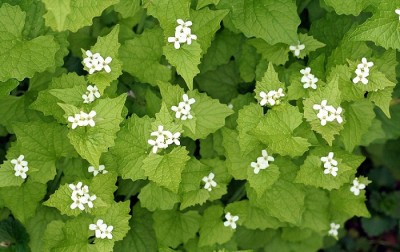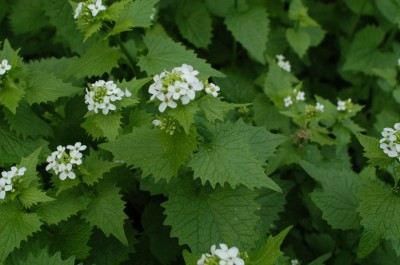
Image source: nyis.info
Garlic mustard (Alliaria petiolata) is a member of the mustard family and has a noticeable garlic aroma — hence its name. In Europe, this plant is loved and used by many rural people, but in North America it is often referred to as a noxious weed. In fact, if you do a search on the Internet you will find a noxious weed alert for almost every state and province.
Those that know the weed well will tell you that the only reason this plant is deemed intolerable is because we are overrun with it from not using it. If only we ate more of it, we likely would feel differently.
How it spreads
Garlic mustard, like other weeds, spreads by seeds that fall just a few feet from each plant. With the help of animals and humans, it gets transported. The first year the plant is small with inconspicuous leaves that blend well with other native plants. They look like violet leaves or wild ginger leaves.
In the second year, a flower stalk shoots up and thousands of seeds are scattered. This aggressive plant soon takes over as its roots exude chemicals that keep other nearby native plants from germinating. This is a problem for areas that contain native plants, as the mustard will soon take over and will eventually ruin the natural diversity of an area. This is why natural foraging is so important, because it helps control the spread.
Beneficial properties
Garlic mustard is good for you, hands down. It is one of the most nutritious leafy greens. There are few other greens that are higher in fiber, beta-carotene, vitamin C, zinc and vitamin E. In addition, garlic mustard beats spinach, collards, turnips, kale, broccoli and domesticated mustard for all nutrients and is high in omega-3 fatty acids, manganese and iron.
Identification
One of the best ways to identify garlic mustard is by its unique underground stem that curves twice as it leads to the root. The first curve is just below the leaves, bending the stem almost on a right angle. The second curve is less acute and further down where it looks like the true root begins. Young leaves can be difficult to spot because they can be rounded, kidney-shaped or even arrow-shaped, depending on the age of the plant. Because of this, foraging novices may be best to look for the unique stem and pungent garlic aroma (crush the leaves and smell).
Could This All-Natural ‘Detox’ Capsule Have Extended John Wayne’s Life?
Once the stem gets large enough, it is easy to spot the changes in leaf shape. The leaves closest to the ground are rounded or kidney-shaped and they become progressively more triangular in shape as they move toward the top of the plant. Flowers appear on the top of the stem in clusters. Each flower has four white petals and a six-stamen set-up that includes four long and two short.
Harvesting

Image source: portgardenclub.org
Larger-rooted, second-year plants are best because they produce more food for the effort. Leaves begin to multiply when temperatures range from the mid-50s during the day to the mid-30s at night. This is usually around the same time that daffodils are blooming.
When you are harvesting in a natural area that you are trying to preserve, it is important to take the whole plant. Use a digging stick or a pick-shovel to uproot the mustard — roots and all. Keep roots with some dirt separate from the leaves if possible. The best way to achieve this is to place the plants in a container with roots down. The best time to harvest is usually after a light rain, as more dirt will stick to the roots.
If you are harvesting in an area that is not already overrun with mustard, you don’t have to be concerned about taking the whole plant. Use sharp and clean scissors to cut the leaves. Gather all of the leaves and cut the cluster at one time. Place the leaves in a clean plastic bag and spray a bit of water inside before tying shut. Harvesting this way leaves the roots intact and you can return to the same spot to harvest over and over as needed. Be careful not to let the plant go to seed if you do not want it to spread.
Be very careful about tossing unwanted roots into your compost bin — they can often regrow and will spread seeds. If you wish to compost them you can cook them first in the microwave; this will kill the seeds. On the other hand, if you wish to have more plants, simply throw out roots in the desired area, rake them a bit underground and water. Soon you will have mustard plants springing up.
Using mustard
Leaves: It is best to keep the leaves in water and to use them right away. You also can place them in your fridge where they will keep for up to 10 days. When you are ready to use, simply remove the leaf stems. Because it has a bit of a bitter taste, it is best to chop leaves up into smaller pieces before using.
Stems: If desired, you can use the upper stems – usually about four inches. Find the place where the stem still snaps cleanly and remove about an inch more. What remains should be good to eat.
The Hidden Secrets Of Making Herbal Medicines…Right At Your Fingertips!
Roots: The roots are edible but need to be fairly large. The core can be woody or crunchy and the outer rind will be mildly sweet. First-year roots are more tender than second-year and both have a slightly peppery taste.
Flowers and buds: You can use these like you would the leaves. They add interest and texture to any dish.
Seeds: Some people use seeds for condiments or spices.
Eating garlic mustard
Garlic mustard is not one of those plants that most of us will bite into and eat freely. It is strong and fairly bitter and therefore better in small bits. Garlic mustard connoisseurs delight in its bitter, garlic and peppery taste that seems to commingle well together.
Garlic mustard is an enjoyable addition to any salad when it is chopped in fine shreds. You also can go ahead and throw in some of the flower heads and buds for good measure. Some recommend pairing garlic mustard with meat dishes and meat sandwiches, as well as bean dishes, eggs and soups. The key is to start with a little and add more as you desire.
If you wish to eat the leaves as greens, you can place them in a pot of boiling water for about six minutes and then eat like you would spinach. Add a little lemon juice and salt for a delicious side dish. You also can steam and sauté the leaves and stems for about 10 minutes.
If you are interested in preserving natural areas, learn how to forage for garlic mustard. You will have an abundant supply of nutritious greens and be making a great conservation effort in the meantime.
Do you eat garlic mustard? Share your foraging and cooking tips in the section below:
Harness The Power Of Nature’s Most Remarkable Healer: Vinegar
 Off The Grid News Better Ideas For Off The Grid Living
Off The Grid News Better Ideas For Off The Grid Living




